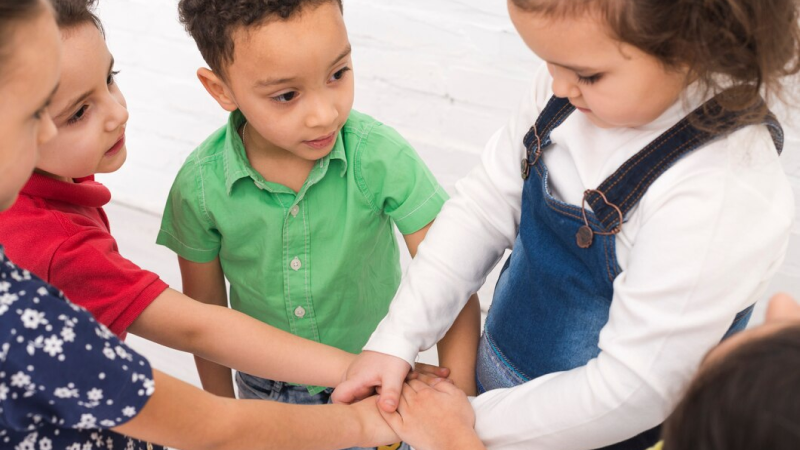Social-emotional learning is an essential part of early childhood education, particularly in primary schools.
The early years lay the foundation for emotional intelligence, empathy, and resilience. This process defines how children learn to understand and manage their emotions, which in turn shapes how they will develop relationships with others around the World.
Social and emotional learning (SEL) skills are invaluable as they are teachable across all educational levels.
Preschools in Bangalore, like Chrysalis Kids, implement this learning in their curriculum. In this blog, we will explore the importance of SEL in Early Childhood Education and its benefits.
What is Social-Emotional Learning?
Early Childhood Social-emotional development involves helping them understand their emotions and feelings, build positive relationships, and the way they appreciate other people’s feelings.
Social-emotional development in early childhood can help students improve their academic performance and emotional intelligence while decreasing inappropriate behaviours. It focuses on core areas such as self-awareness, self-management, social awareness, relationship skills, and decision-making.
That fosters a positive school culture for every student and creates a sense of belonging among students.
Benefits of SEL in Early Childhood
Here are some benefits of SEL in Early Childhood –
Develop Resilience:
SEL helps children equip themselves with skills for dealing with challenges and setbacks. It helps to develop the ability to navigate through stressful situations and setbacks, fostering resilience and helping them prepare to handle challenges.
Improved Social Skills:
Through activities like group play and storytelling, children learn teamwork, empathy, and communication.
Better Academic Outcomes:
SEL is closely linked to academic success. Children who feel emotionally secure can focus their attention on learning, but it also helps them learn skills like cognitive development, problem-solving, and staying focused.
Building Positive Relationships:
It teaches children important soft skills like sharing, turn-taking, and having empathy. Preschoolers can learn to make new friends, build social networks, and see things from different points of view.
Lifelong Success:
SEL prepares children for a lifelong path to success by developing their emotional skills, shaping their emotional well-being, and fostering their social involvement.
Implementing SEL in Early Childhood Education
Here are some practical steps for implementing social-emotional learning in the classroom –
Interactive Activities:
Activities of Social-Emotional Learning like Role-play and group challenges further enhance the child’s emotions and social contexts. Communicating effectively and working together are messages children should learn while enjoying themselves by engaging in dramatic and interactive play.
Storytelling:
Children can explore emotions and relationships creatively through stories, puppetry, and art projects. These activities stimulate discussion about feelings and appropriate responses.
Parental Engagement:
Encouraging parents and family to be involved in SEL activities can reinforce learning at home. Providing children with resources and strategies to support their children’s social-emotional development creates a consistent approach.
Teach Emotional Regulation:
Teach children strategies for identifying and managing their emotions, such as deep breathing, mindfulness exercises, and calm-down techniques.
Teacher Training :
SEL-trained educators cultivate inclusive classrooms where every child feels valued. Teachers use emotional learning strategies to meet children’s needs and promote self-awareness, empathy, and conflict resolution.
Challenges in Integrating SEL and How to Overcome Them
Even though Social and Emotional Learning has many positive aspects, SEL can be challenging to implement –
- Time Constraints: Balancing academic priorities with SEL can be challenging for educators. Thus, they need creative ideas to integrate SEL into everyday activities to promote holistic development.
- Diverse Needs: Each of the children comes from a different background and hence requires a different approach to their needs. It is the ability to be sensitive to cultural and personal differences that make social-emotional learning inclusive and effective.
Conclusion
Social-emotional learning (SEL) is essential for development in the early years. Children need a supportive environment, structured programs, and prepared educators to help them integrate SEL into their lives.
Preschools in Bangalore, like Chrysalis Kids, implement an SEL-focused curriculum to prepare children for future academic and emotional rigours.
FAQs
- What is the role of parents in SEL?
Parents play a key role by modelling emotional regulation, fostering open communication, and encouraging empathy at home. - How do caregivers support social-emotional development?
Caregivers create nurturing spaces, encourage cooperative play, and guide children in managing emotions. - How can I practice SEL at home?
Learn empathy, teamwork, and self-awareness through storytelling, role play and discussions about emotions. - What are the 4 pillars of SEL?
The four elements, self-awareness, social awareness, relation skills, and self-management, are the roots of developing emotional intelligence, which will continue throughout life.
